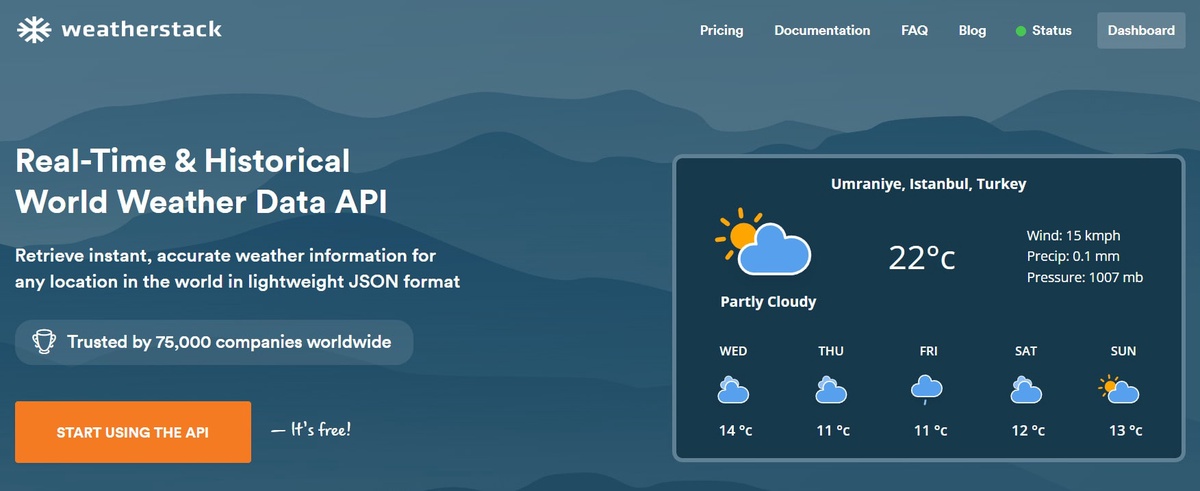Weather impacts nearly every aspect of our daily lives, from deciding what to wear in the morning to planning long-term activities like vacations and outdoor events. With the advancement of technology, access to real-time weather data has become more convenient than ever before. In this article, we'll dive into the challenges and opportunities presented by real-time weather data, its applications, and the various weather APIs that provide this crucial information.
Introduction to Real-Time Weather Data
Real-time weather data refers to up-to-the-minute information about current weather conditions, such as temperature, humidity, precipitation, and wind speed. It provides insights into the current state of the atmosphere, helping individuals and businesses make informed decisions. Whether it's a farmer checking conditions before planting crops or a commuter planning their route, real-time weather data has a broad range of applications.
Challenges in Accessing Real-Time Weather Data
Real-time weather data is a valuable resource, but there are challenges to accessing it effectively:
- Data Quality and Accuracy: Weather data is collected from various sources such as weather stations, satellites, and weather radar. Ensuring the accuracy and quality of this data can be a challenge.
- Coverage and Availability: Weather data collection varies by region, with some areas having limited or no data coverage. This can impact the availability of real-time data in certain locations.
- Cost: Some best weather APIs come with a cost, which may be a barrier for individuals or small businesses seeking access to real-time weather data.
- Data Integration: Integrating real-time weather data into applications and systems can be complex, especially when working with different data formats and sources.
Opportunities in Real-Time Weather Data
Despite the challenges, real-time weather data offers numerous opportunities:
- Enhanced Decision-Making: Businesses can use real-time weather data to make informed decisions about operations and logistics.
- Safety and Emergency Preparedness: Real-time data can help governments and emergency services respond quickly to weather-related disasters.
- Improved Efficiency: Industries like agriculture, energy, and transportation can optimize their operations based on current weather conditions.
- Innovative Applications: Access to real-time data has led to the development of innovative applications such as weather dashboard JavaScript widgets, mobile weather apps, and weather-based IoT devices.
Top Weather API
A variety of weather information APIs provide real-time data for developers to integrate into applications. Here are some of the top weather APIs available:
- OpenWeatherMap: Known for its comprehensive and free data offerings, OpenWeatherMap provides real-time weather data and forecasts.
- AccuWeather API: Offers detailed forecasts and current conditions, including air quality and severe weather alerts.
- Weatherbit API: Provides high-resolution weather data and forecasts, with both free and paid plans available.
- Weatherstack API: An Overview
Weatherstack API is a popular choice for accessing real-time weather data. It provides up-to-date information on current weather conditions, forecasts, and historical data. The API is known for its simplicity and ease of integration, making it a favorite among developers.
Rest API Weather
Rest API Weather allows developers to access real-time weather data through a weather REST API. This type of API uses standard HTTP methods to request and receive weather data, making it easy to integrate into web applications.
Public Weather API
A public weather API offers free access to current weather data API for developers and users. Public weather APIs are often supported by government agencies or organizations that aim to provide open access to weather information.
Best Free Weather API
While some weather service APIs come with a cost, there are several free weather API JSON options available:
- WeatherAPI: Provides a range of free weather data, including current conditions and forecasts.
- Visual Crossing Weather: Offers free and paid plans for weather data, including historical data and forecasts.
- MetaWeather: Known for its user-friendly API and free access to real-time weather data.
Applications of Real-Time Weather Data
Real-time weather data has numerous applications across various industries:
- Agriculture: Farmers use real-time data to plan planting and harvesting schedules, optimize irrigation, and protect crops from adverse weather conditions.
- Transportation: Airlines and shipping companies use real-time data to plan routes and avoid weather-related disruptions.
- Energy: Energy companies rely on weather data to manage power generation and distribution.
- Public Safety: Emergency services use real-time data to monitor and respond to weather-related disasters.
The Future of Real-Time Weather Data
The future of real-time weather data looks promising, with advances in technology and data collection methods. We can expect to see:
- More Accurate Forecasts: Improved data collection and analysis will lead to more accurate and reliable weather forecasts.
- Increased Accessibility: As technology advances, real time weather API will become more accessible to individuals and businesses worldwide.
- Innovative Applications: The continued development of weather-based applications will lead to new ways of using real-time data for various purposes.
Conclusion
Real time weather API presents both challenges and opportunities. As technology advances, these challenges will become easier to manage, and opportunities will continue to grow. From businesses to individuals, real-time weather data offers valuable insights that can enhance decision-making, improve safety, and lead to innovative applications.
FAQs
What is real-time weather data?
Real-time weather data refers to up-to-the-minute information about current weather conditions, such as temperature, humidity, precipitation, and wind speed.
What are the challenges in accessing real-time weather data?
Challenges include data quality and accuracy, coverage and availability, cost, and data integration.
What opportunities does real-time weather data offer?
Opportunities include enhanced decision-making, safety, and emergency preparedness, improved efficiency, and innovative applications.
What are some of the best weather APIs available?
OpenWeatherMap, AccuWeather API, and Weatherbit API are some of the top weather APIs available.
How can real-time weather data benefit different industries?
Real-time weather data can benefit industries such as agriculture, transportation, energy, and public safety by providing valuable insights for planning and decision-making.


No comments yet